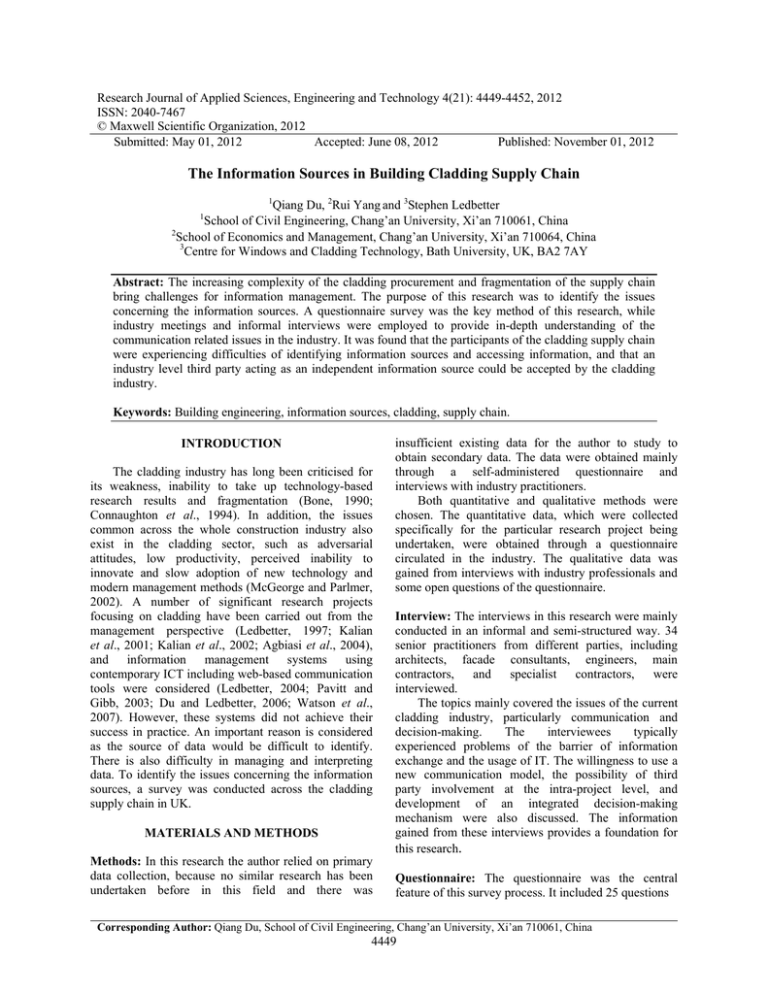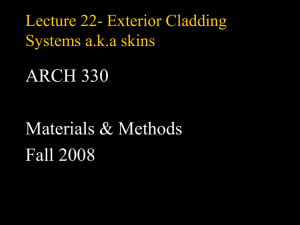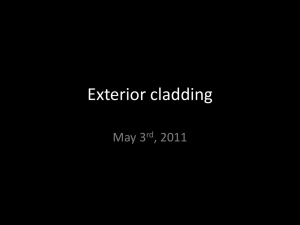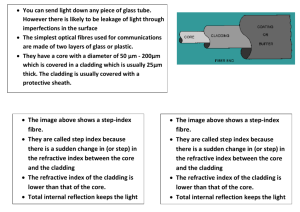Research Journal of Applied Sciences, Engineering and Technology 4(21): 4449-4452,... ISSN: 2040-7467
advertisement

Research Journal of Applied Sciences, Engineering and Technology 4(21): 4449-4452, 2012 ISSN: 2040-7467 © Maxwell Scientific Organization, 2012 Submitted: May 01, 2012 Accepted: June 08, 2012 Published: November 01, 2012 The Information Sources in Building Cladding Supply Chain 1 Qiang Du, 2Rui Yang and 3Stephen Ledbetter School of Civil Engineering, Chang’an University, Xi’an 710061, China 2 School of Economics and Management, Chang’an University, Xi’an 710064, China 3 Centre for Windows and Cladding Technology, Bath University, UK, BA2 7AY 1 Abstract: The increasing complexity of the cladding procurement and fragmentation of the supply chain bring challenges for information management. The purpose of this research was to identify the issues concerning the information sources. A questionnaire survey was the key method of this research, while industry meetings and informal interviews were employed to provide in-depth understanding of the communication related issues in the industry. It was found that the participants of the cladding supply chain were experiencing difficulties of identifying information sources and accessing information, and that an industry level third party acting as an independent information source could be accepted by the cladding industry. Keywords: Building engineering, information sources, cladding, supply chain. insufficient existing data for the author to study to obtain secondary data. The data were obtained mainly through a self-administered questionnaire and interviews with industry practitioners. Both quantitative and qualitative methods were chosen. The quantitative data, which were collected specifically for the particular research project being undertaken, were obtained through a questionnaire circulated in the industry. The qualitative data was gained from interviews with industry professionals and some open questions of the questionnaire. INTRODUCTION The cladding industry has long been criticised for its weakness, inability to take up technology-based research results and fragmentation (Bone, 1990; Connaughton et al., 1994). In addition, the issues common across the whole construction industry also exist in the cladding sector, such as adversarial attitudes, low productivity, perceived inability to innovate and slow adoption of new technology and modern management methods (McGeorge and Parlmer, 2002). A number of significant research projects focusing on cladding have been carried out from the management perspective (Ledbetter, 1997; Kalian et al., 2001; Kalian et al., 2002; Agbiasi et al., 2004), and information management systems using contemporary ICT including web-based communication tools were considered (Ledbetter, 2004; Pavitt and Gibb, 2003; Du and Ledbetter, 2006; Watson et al., 2007). However, these systems did not achieve their success in practice. An important reason is considered as the source of data would be difficult to identify. There is also difficulty in managing and interpreting data. To identify the issues concerning the information sources, a survey was conducted across the cladding supply chain in UK. Interview: The interviews in this research were mainly conducted in an informal and semi-structured way. 34 senior practitioners from different parties, including architects, facade consultants, engineers, main contractors, and specialist contractors, were interviewed. The topics mainly covered the issues of the current cladding industry, particularly communication and decision-making. The interviewees typically experienced problems of the barrier of information exchange and the usage of IT. The willingness to use a new communication model, the possibility of third party involvement at the intra-project level, and development of an integrated decision-making mechanism were also discussed. The information gained from these interviews provides a foundation for this research. MATERIALS AND METHODS Methods: In this research the author relied on primary data collection, because no similar research has been undertaken before in this field and there was Questionnaire: The questionnaire was the central feature of this survey process. It included 25 questions Corresponding Author: Qiang Du, School of Civil Engineering, Chang’an University, Xi’an 710061, China 4449 Res. J. Appl. Sci. Eng. Technol., 4(21): 4449-4452, 2012 Table 1: Questionnaire responses by company types Company type No. Architect 7 Client 3 Engineer/consultant 18 Main contractor 5 Manufacturer/supplier 12 Specialist contractor 17 (%) 11.3 4.8 29.0 8.1 19.4 27.4 and could be divided into four sections: respondents’ demographic information, extra-project level information sources, intra-project level communication, and CWCT focused comments. The questionnaire served to develop the conceptual model of integrated communication and decision making, and partly validated the idea. Respondents: 869 professionals were invited to answer the questionnaire on-line. Some people, who visited the CWCT web site regularly, though outside the mailing list, also responded to the questionnaire. In total 62 valid responses were received. Table 1 shows the respondents to the questionnaire, as well as the percentages of returned questionnaires per group of organisations. The positions of the respondents include project coordinator, technical manager, Chairman, head of structural department, principal engineer, architect, procurement manager and so on. 34% of the respondents claimed that they worked for member organisations of CWCT. By regions, the percentages of respondents are illustrated in Fig. 1. Many respondents left the reply of ‘companies size’ blank, but from the limited answers, it can be seen the turnover of their companies range from £200k to £3 billion, and number of employees from 1 to 5,700 worldwide. Analysis: In order to have a deep understanding of the data obtained from the questionnaires, the Statistical Package for the Social Sciences (SPSS) was used to analyse the responses. Other mental interpretations may also be considered to be effective, particularly as the author has an intensive understanding of the cladding industry and may look for more complex patterns of response. The mixed use of quantitative and qualitative methods and various data collection methods enabled checking of the reliability of the data and the validity of the methodology. On the other hand, most of the respondents of the surveys hold senior positions in the different companies; therefore their in-depth understandings and opinions from various perspectives provided extra validity to the data. RESULTS The following are the findings from the results of the questionnaire survey: Finding 1: Currently, different parties rely on various types of information sources, and the formality of and QA procedures applied to information sources are inadequate. Results present the diversity of the information sources and demands between different parties. Results illustrate the inadequate formality of knowledge networks and show the lack of QA procedures applied to sources of information. In this research, in-house information sources mainly include library, intranet, specialist, project or section manager, line manager and knowledge network; while external knowledge sources comprise standards, trade association literature, manufacturer literature, manufacturer technical advisory service, certification schemes, and consultants. The types of information sources that different groups use are characterised by the nature of their work. In general, the clients have the most limited information sources on cladding. None of them have a facade knowledge network and they use the external cladding information sources relatively infrequently. This reflects the reality that clients do not need to focus on 14% UK 45% 36% 5% Fig. 1: Respondents by regions 4450 Eur opean oper at i ng i n UK I nt er nat i onal oper at i ng i n UK Oper at i ng el eswher e Res. J. Appl. Sci. Eng. Technol., 4(21): 4449-4452, 2012 the cladding aspect. Main contractors have no company libraries due to the temporary nature of the construction sites, while all consultants have company libraries as they are working in a relatively stable office. A consultant often needs to play the role of a coordinator between parties, which means the consultant has the most balanced information sources. Most respondents from the parties other than the client have in-house specialists; this indicates the increasing complexity and importance of facade engineering. Regarding external sources, the majority of the consultants, manufacturers, and specialist contractors use standards and other external sources more frequently than the other three parties; this matches their roles of cladding-focused service providers in the supply chain and their need for more specific information than clients, architects and main contractors. They still need to outsource the information and knowledge that they do not have internally. This means, in fact, that these three parties need more external information providers. Every party has its own information sourcing style; however, the quality assurance aspects are generally flawed. Only 48% of the respondents (excluding the cladding specialists) have a formal knowledge network (16% of manufacturers, 0% of clients); and only 35.9% of the respondents have QA procedures on sources of information. As a perceived informative/knowledgeable party in the cladding supply chain, only 16.7% of the consultants have QA procedures though 72% of them have a formal knowledge network. These facts imply that the information sources are often not well organised and assured, which may adversely affect decision-making. There are diverse information sources for participants in the cladding supply chain, but the quality of the information sources is not secured. It is difficult for participants to indentify the appropriate information sources, and showing that the participants frequently disagree with external sources of information and encounter conflicting information. Finding 2: The majority of the participants in the industry frequently experience difficulties of accessing information. The results confirm that most of the practitioners in the industry quite frequently experience barriers to accessing information, and imply that the current decision-making timeframe needs to be adjusted. The responses indicate some key reasons for the barriers and show problems arising from fragmentation of the supply chain. According to the results, the barriers to accessing information sources can be ranked in descending order of frequency as follows: work load, time scale, conflicting information, inability to access, and inability to agree. All of them are marked from ‘occasionally’ to ‘often’ by the majority of the respondents. ‘Conflicting information’ and ‘inability to agree’ may be caused by diverse and unreliable information sources, as discussed under Finding 1. A facade engineer pointed out that information from some sources was vague or scarce, and a main contractor cited “contradictory specification requirements”. ‘Inability to access information’ means that the practitioners are unable to share information that they need. The reasons for this have been partially exposed in responses, such as intelligence protection (“software licenses”), communication issues (“the lack of coordinated procedures of all sub-contractors”), as well as adversarial attitudes (“unhelpful suppliers”). Of course, some confidential information may be restricted for specific participants. ‘Work load’ and ‘time scale’ are rated as the top two barriers to accessing information. In particular, cladding specialists and manufacturers may play a key part in detailed design and system design, and they need to have the most detailed and specific information available. However, a large proportion of the manufacturers and cladding specialists suffer from accessing information sources with the reasons given as work load and time scale, which reflects that the detailed design actually needs more time to be allocated. This problem would be eased by earlier appointment of specialist contractors. Finding 3: There are too few qualified practitioners and training opportunities for practitioners in the cladding industry are limited. Results show that there is a shortage of adequately qualified practitioners (decision makers) and education/training opportunities for practitioners in the industry are limited. The professional education and training levels partially determine the quality of the decision makers and of the decisions they make. Facade engineering was traditionally an ‘empirical’ form of engineering with people learning from one another ‘on the job’; however, the increasing complexity of building facades requires the decision makers to have more structured theoretical knowledge. At the same time, the education and training providers are an important information sources for the participants. The results show that only 30.6 percent of respondents hold qualification in facade engineering and 50 percent of them have no access to mid-career training. It suggests many practitioners of the industry need to be further trained and relevant companies should provide more opportunities for education and training of their employees. 4451 Res. J. Appl. Sci. Eng. Technol., 4(21): 4449-4452, 2012 Finding 4: ICT facilities have been widely used in the construction industry, but there is still a large potential for improvement. The results show the majority of the respondents use ICT facilities instead of the traditional ‘face to face’ method of accessing the facade knowledge network. The results show almost all the respondents have experience of using an extranet or other IT platforms to host project information. These results actually show that ICT facilities have been widely used in the construction industry. However, it is also implied that the usage of electronic applications has a big potential for improvement in the industry. For instance, all the respondents from main contractors use e-mail to access a facade knowledge network but no one uses an extranet, and most IT platforms only contain basic information, such as drawings and specification, rather than performing as interactive communication and collaborative decision-making platforms. Therefore, the industry still has a long way to go to make the best use of ICT and modern electronic applications. Also, thank the sponsorship from Central University Fund (CHD2010JC100) and Shaanxi Science Research Fund (2011KRM03). REFERENCES Agbiasi, E., C. Anumba, A. Gibb, A. Kalian and A. Waston, 2004. Cladding sector road map for realising the CIM vision. Indust. Manage. Data Syst. Emerald Group Publish. Ltd., 104(6): 526532. Bone, R., 1990. Curtain Walling for the Construction Industry-An Appraisal of the UK Market and UK Supplier Opportunities and Proposals for Improvement. British Library Document Supply Centre, United Kingdom, pp: 53, ISBN: 0-72920998-9. Connaughton, J., N. Jarrett and E. Shove, 1994. Innovation in the Cladding Industry. Department of the Environment, UK. Du, Q. and S. Ledbetter, 2006. Integrated design decision-making in the cladding supply Chain. The CONCLUSION 10th International Conference on Computer Supported Cooperative Work in Design, (CSCWD The extension rule is defined as follows. The information sources used in the cladding supply chain '06), Dept. of Archit. Civil Eng., Univ. of Bath, pp: were clarified in this study. Four main findings relating 1-4. to information sources and communication in the Kalian, A., A.Watson, E. Agbasi, C.J. Anumba and cladding industry were gained from the results of the A.G.F. Gibb, 2001. ICT usage: Current and future. questionnaire survey. The formality of and QA Computer-Integrated Manufacture of Cladding procedures applied upon information sources are Systems (CIMclad) Report 2, University of Leeds, inadequate, as well as the practitioners frequently UK. experience difficulties in accessing information in the Kalian, A., A. Watson, E. Agbasi, C. Anumba and A. industry. These issues may considerably impact Gibb, 2002. Software deployment scenarios and decision making process and results. Efficient evaluation criteria. Computer-Integrated communication mechanisms are needed. In addition, Manufacture of Cladding Systems (CIMclad) from the informal interview, it appears that these Report 5, University of Leeds, UK. interviewees reflected on the way they communicate. It Ledbetter, S., 1997. Mapping and Quantifying the also made significant contribution to the literature of Curtain Wall Industry. CWCT, Bath, UK. this area. Ledbetter, S., 2004. Communication down the Cladding The limitation of this research concerns the sample Supply Chain. Center for Window and Cladding of the survey. The size of sample was relatively small Technology, Bath, UK. for the industry and there was a shortage in respondents McGeorge, D. and A. Parlmer, 2002. Construction from clients and main contractors. At the same time, Management-New Directions. Blackwell Science, most of the interviewees and respondents hold senior Oxford, pp: 304. positions, which may provide more in-depth views but Pavitt, T.C. and A.G.F. Gibb, 2003. Interface opinions from junior practitioners are also valuable for management within construction: In particular, the research. building façade. J. Constr. Eng. Manage., 129(1): 8-15. ACKNOWLEDGMENT Watson, A.S., A. Kalian, A.G.F. Gibb, C.J. Anumba and E. Agbasi, 2007. Capturing a rainscreen The authors would like to thank the Centre for cladding scheme design. Comput. Aid. Civil Windows and Cladding Technology (CWCT) in UK, for funding this work and offering internal publications. Infrastruct. Eng., 222: 149-161. 4452




